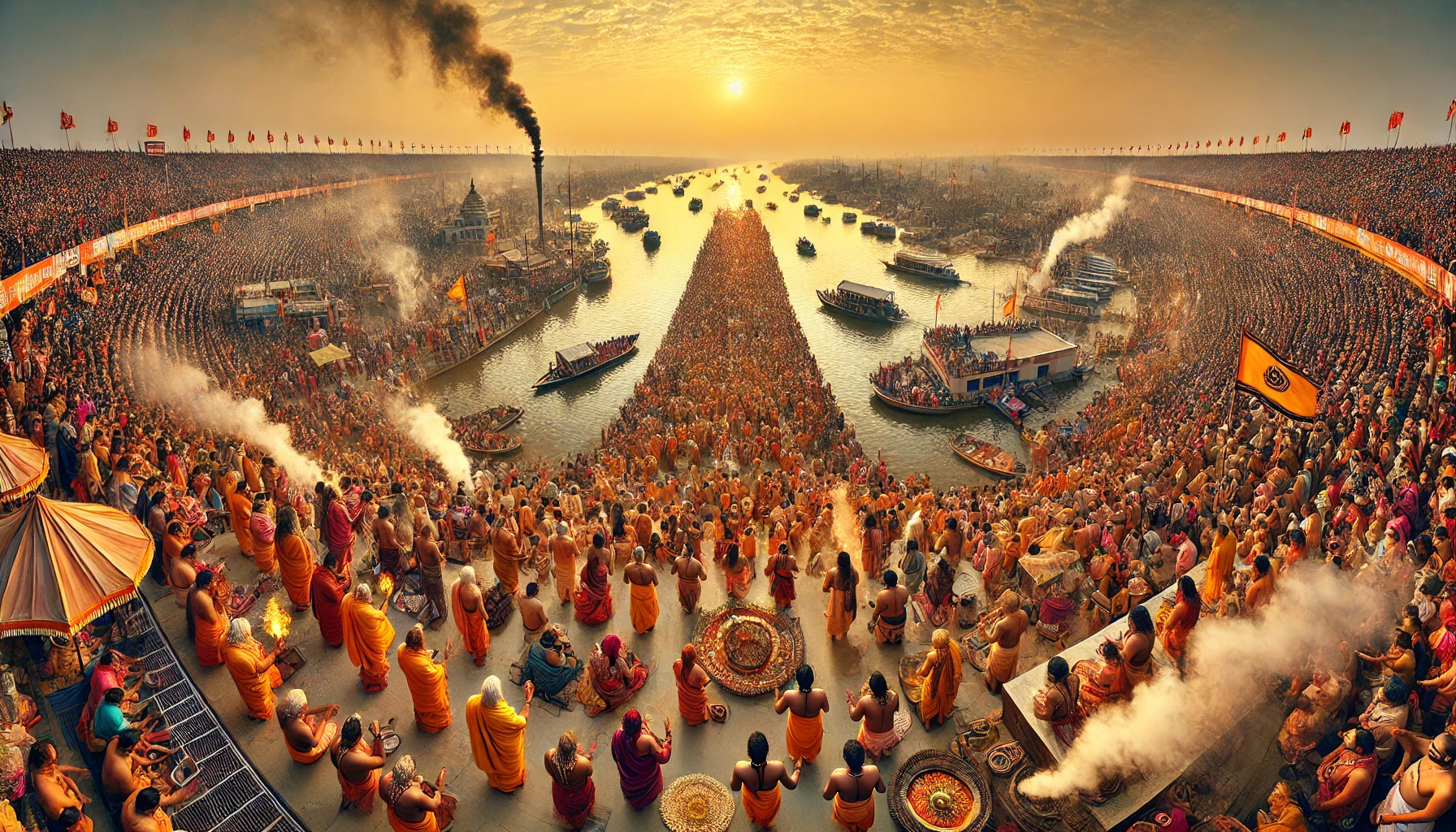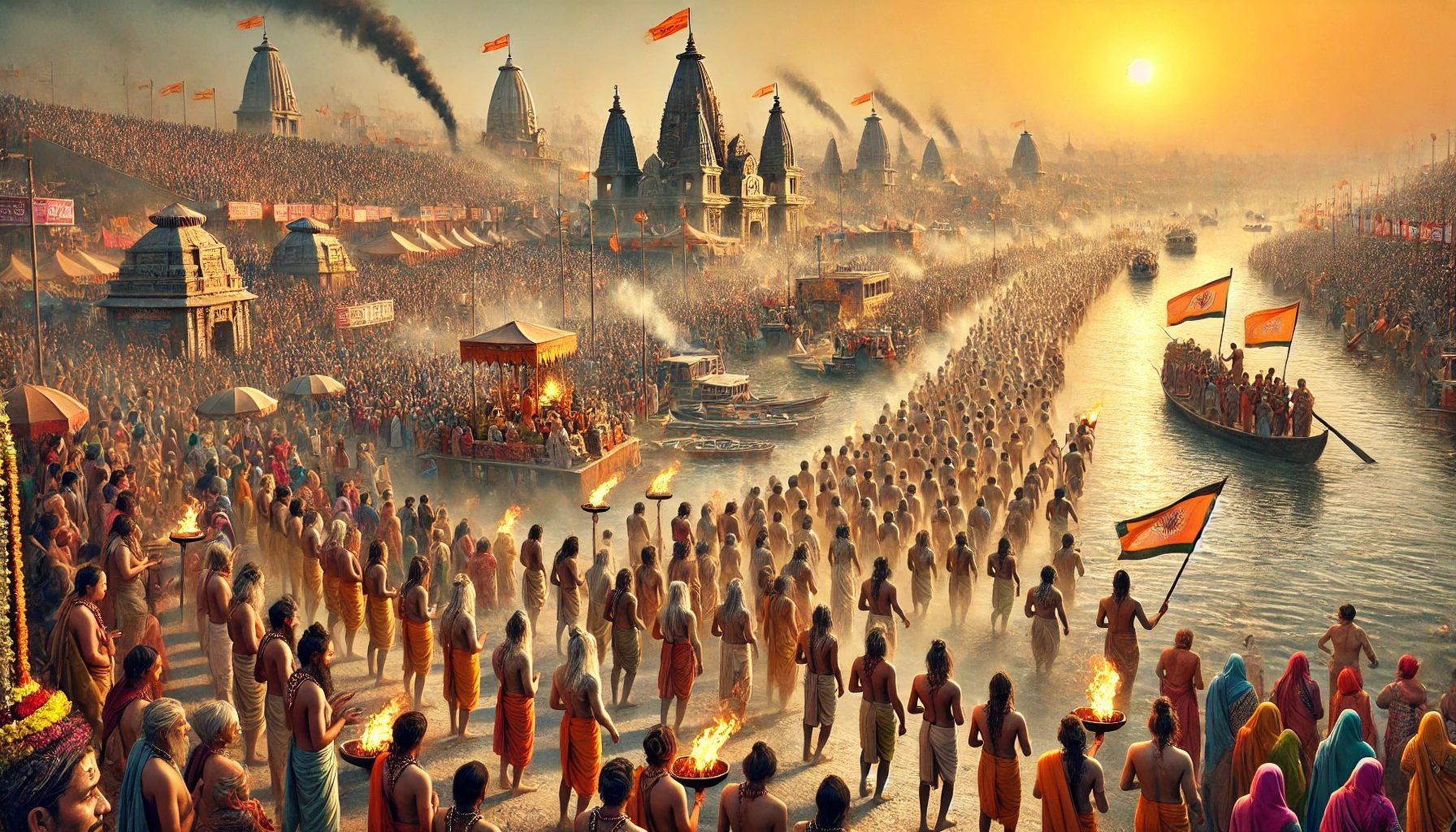Kumbh Mela, also known as Kumbh Ka Mela, is the grandest and most sacred religious gathering in the world. This unique festival, held in four different locations across India, attracts millions of devotees, saints, spiritual seekers, and tourists from all over the world. The Kumbh festival is deeply rooted in Hindu mythology and has been celebrated for centuries, marking a significant spiritual, cultural, and social event. This article provides an in-depth exploration of all about Kumbh Mela, including its origins, history, significance, locations, rituals, impact, and the grand experiences it offers to its visitors.
Origins and Mythological Significance of Kumbh Mela
The Kumbh Mela story originates from the Hindu legend of the Samudra Manthan (Churning of the Ocean), which is mentioned in ancient scriptures such as the Bhagavata Purana, Vishnu Purana, and the Mahabharata. According to the legend, the Devas (gods) and Asuras (demons) fought over a pot (Kumbh) of Amrit (nectar of immortality). In this cosmic struggle, Lord Vishnu took the form of Mohini, the celestial enchantress, and carried away the pot of nectar to protect it from the demons.
During the chase, a few drops of the nectar fell at four locations on Earth, sanctifying them forever. These locations later became the sites of the Kumbh Mela festival. The belief is that bathing in these sacred rivers during the Kumbh period cleanses one’s sins and grants liberation (Moksha). This deep-rooted faith has made Kumbh Mela the most significant Hindu pilgrimage event.
Kumbh Mela Locations & Sacred Places

Kumbh Mela places are four significant pilgrimage sites where the festival is held in a rotational manner. These sites are:
- Prayagraj (Allahabad) – Located at the confluence (Sangam) of the holy Ganga, Yamuna, and the mystical Saraswati rivers, Prayagraj is considered the most auspicious site for the Kumbh Mela. It hosts the Maha Kumbh Mela, the largest and most significant form of the event, once every 144 years.
- Haridwar – Situated on the banks of the sacred Ganga River, Haridwar is another significant Kumbh Mela location. The river is believed to be most pure here, making it an ideal spot for spiritual purification.
- Ujjain – Located on the banks of the Shipra River, Ujjain is associated with Lord Shiva and is home to the famous Mahakaleshwar Jyotirlinga. The spiritual energy of this place makes it a powerful center for the Kumbh festival.
- Nashik – The fourth site is Nashik, located on the banks of the Godavari River, which is often referred to as the “Ganga of the South.” It is closely linked to Lord Rama and is a significant pilgrimage site.
Each of these Kumbh places holds immense religious importance, and during the festival, they transform into a vibrant spiritual hub attracting millions of devotees.
Kumbh Mela Schedule and Astrological Importance
The Kumbh Mela schedule is determined by astrological calculations. The positioning of Jupiter (Brihaspati), the Sun, and the Moon in different zodiac signs influences the timing of the event. The types of Kumbh Mela include:
- Maha Kumbh Mela – Held once every 144 years only in Prayagraj.
- Purna Kumbh Mela – Occurs once every 12 years at each of the four locations.
- Ardh Kumbh Mela – Happens every 6 years in Prayagraj and Haridwar.
- Magh Mela (Mini Kumbh) – An annual event in Prayagraj, leading up to the grand Kumbh Mela.
Rituals and Ceremonies at Kumbh Mela
The Kumbh Mela festival is marked by numerous spiritual and religious activities, including:

1. The Sacred Bathing (Shahi Snan)
The highlight of the Kumbh is the Shahi Snan (Royal Bath), where millions of devotees take a holy dip in the river. It is believed that bathing during the auspicious time washes away sins and leads to spiritual enlightenment.
2. Processions of Sadhus and Akharas
One of the most visually striking elements of the Kumbh Mela photography is the grand processions of Naga Sadhus, Aghoris, and various sects of monks belonging to different Akharas (monastic orders). These saints march towards the river with great devotion, performing rituals and displaying unique practices.
3. Religious Discourses and Yajnas
Spiritual leaders and scholars conduct pravachans (discourses), yajnas (fire rituals), and bhajans (devotional songs), spreading messages of peace and knowledge.
4. Annadan (Food Distribution)
Many charitable organizations set up free food stalls, offering Prasadam to millions of devotees and underprivileged individuals.
5. Cultural Events and Exhibitions
The Kumbh festival showcases India’s diverse cultural heritage through folk performances, spiritual art, and exhibitions.
Significance of Kumbh Mela
The Kumbh Mela significance extends beyond religion; it is a social and cultural phenomenon. It fosters unity, brings together saints and scholars, and offers a platform for interfaith dialogues. The event also contributes significantly to tourism and the economy, creating employment opportunities for thousands.
Kumbh Mela Photography & Media Influence
Kumbh Mela photography captures the essence of this grand festival, showcasing the spiritual intensity, the vibrant crowds, and the stunning visuals of mass rituals. Over the years, the festival has gained global recognition, with international photographers, journalists, and documentarians covering its extraordinary scale and diversity.
Challenges and Management of Kumbh Mela
Organizing an event of such a massive scale presents challenges, including:
- Crowd Management: Ensuring the safety of millions is a critical task.
- Sanitation & Hygiene: Maintaining cleanliness amidst a vast gathering requires extensive planning.
- Security Arrangements: Preventing stampedes and ensuring safety from potential threats.
- Infrastructure & Transport: Developing temporary roads, bridges, and accommodations for pilgrims.
The Indian government collaborates with local authorities, NGOs, and technological experts to implement smart crowd control systems and AI-based surveillance.
View More : India vs Bangladesh Champions Trophy
Conclusion
The article on Kumbh Mela emphasizes its spiritual grandeur, historical significance, and massive scale. Whether you are a pilgrim seeking salvation or a traveler eager to witness this unparalleled event, the Kumbh festival is a once-in-a-lifetime experience. The Kumbh Mela continues to be an embodiment of faith, unity, and cultural vibrancy, standing as a testament to India’s rich religious traditions.















Leave a Reply